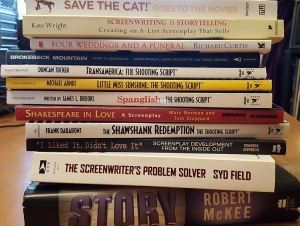Rainy taxi windows and longing glances. . . if you’re looking for a romantic movie, Carol gives you that rip-your-heart-out angst that romantics like me love. However, parts of the story are problematic. But we’ll get to that.
First, let me confess that I haven’t yet read the book on which the film is based, The Price of Salt, the classic novel by Patricia Highsmith. For this reason, I can’t comment on the way the book was adapted. I can only comment on the film as a stand-alone entity.
The premise
An upper class woman, Carol (Cate Blanchett) meets a struggling photographer, Therese (Rooney Mara) who works in a department store. One of the best scenes is the first time they catch each other’s eyes across a crowded, holiday-decorated store.
Every look and glance is, of course, important because this story is set in 1950s New York. In that era, if you were a woman who was attracted to another woman and you guessed wrong about her, your whole life could be destroyed—causing you to lose your family or your job, everything. Carol, who has had an affair with a woman before, has everything to lose now. She must deal with 1950s attitudes when it becomes clear that her husband isn’t the love of her life, and most likely never will be. She’s thought to have a mental disorder and has been subjected to psychiatric examinations in order to keep even part-time custody of her only daughter.
The characters
Carol was kind of a fascinating, ethereal creature, moving about her 1950s world with elegance and an (almost) endless supply of cigarettes. Her voice and pout recalled that breathy glamour of Hollywood sirens of the period.
Therese, on the other hand, came dangerously close to a paper doll. She’s often sullen, wide-eyed and of course, you can surmise that she’s still figuring out who she is. However, in this case, the script took the “less is more” mantra to an extreme that resulted in a “less equals less, almost non-existent” character. I was grateful for Therese’s monologue in the car scene where she finally lets it fly, even for a moment—the struggle with how she always says yes, which reveals a lost soul underneath it all. Whew! There was a person in there after all.
What works
Carol is shot like an art house film. Director Todd Haynes shot it in 16mm to reflect the photography of 1952, adding a grainy realism to the film. There are also long silences and scenes that don’t always let you in, making you feel as though you’re an observer through apartment windows or from inside moving cars. This indie style suits the intensely emotional, delicate nature of the story and seems to work well.
What doesn’t work
As I mentioned, it’s set in the 1950s. So it would have been good to add scenes that show what the main characters are up against (unless these scenes were cut from the final film). It would help to see the “model” family of this era and the limited choices available to women. While this was touched upon, and made more obvious in scenes between Carol and her husband, it could have been shown more, and in even subtle ways, such as stares from patrons in the record store in the scene where Therese notices two women who are presenting themselves in a way that’s atypical for their gender. To make audiences aware of what the cost of being a lesbian was during this time is necessary to build the conflict of the story. Your place in society and your very life were at risk. We shouldn’t take for granted that audiences of all ages automatically understand this. Speaking of that. . .
Many of today’s young actors who consider themselves bisexual or “sexually fluid”, like Kristen Stewart, represent a new generation who have commented that they don’t see the big deal about labels and scrutiny of one’s sexuality. While that perspective may prevail in a perfect, all-inclusive future world, we’re still not there yet, and the history of what lesbians endured in past decades shouldn’t be forgotten. It explains why there WAS a need to stand up and identify yourself (call it labeling, whatever)—it took courage to go against the grain. Dismissing labels or the need to identify oneself doesn’t do justice to the brave women who came before us.
Now that I’ve gotten that off my chest. . .
One criticism I’ve heard about the film Carol was that the pacing was too slow. Actually, I felt like the story moved too quickly. As I’ve said, the story is set in a time when you had to be careful about what woman you approached and how. So why on earth would Carol be so comfortable asking another woman whom she’s already asked to lunch if she’ll stop by her place later? “Will you see me Sunday? Would you like to come by my house?” Maybe the martini gave her extra courage, but it doesn’t seem to ring true. Even today, it can be an awkward dance when you don’t know who is or who isn’t. So wouldn’t that have been too forward, considering all she had to lose? It felt rushed, moving them together too fast. Maybe it would have worked better to show some clumsy, awkward moments where Carol tries to figure out whether or not Therese will be receptive to her advances.
When you watch a love story, you want to know what it is that makes the two people fall in love with each other. I struggled to see and feel the connection between these two. I’ll explain this later. However, before I continue, let me say that there were some very well-crafted moments that help you to feel something of their connection. When Carol’s hand touched Therese’s shoulder, you felt it. When Therese was almost breathless in Carol’s presence, you felt it. These moments were delicious, beautifully done and thankfully included to make up for some of what was missing from the film.
What’s missing
The screenplay seemed to rely too much on the actors’ abilities to convey their characters’ inner thoughts. While Blanchett and Mara did a phenomenal job with facial expressions and the subtle nuances of falling in love and, at times, coming apart, we needed more—dare I say it–dialogue between the women! Yes, that’s a suggestion you hardly ever hear about a movie. But this one could have used more. And I’ll tell you why. . .
In books you can share the characters’ inner thoughts and feelings. On film, it’s more difficult to show this. So at times it would have been helpful to see more conversation. Example: In that same car scene I mentioned earlier, Carol has asked Therese what she is thinking, then adds, “You know how many times a day I ask you that question?” Well, no. We don’t know how much she’s asked that question. We hardly ever see them really talk to each other!
Compare this to the 1980s film, Desert Hearts, where the characters Cay and Vivien are like sparks crackling off each other. It’s fun to watch Vivien, the uptight professor, arguing with Cay, the rebellious free spirit, after Cay mocks Vivien’s need to analyze their first kiss. We know these two. We understand why they’re attracted to each other. Unfortunately, I didn’t feel this from Carol. I really, really wish I did.
The best things about Carol
It is a love story between women set during a time when this wasn’t acceptable, so the inherent conflict is exciting. And Cate Blanchett is an incredibly talented and versatile actor who can make you believe anything with a mere look or glance. Rooney Mara is also amazingly versatile (remember The Girl with the Dragon Tattoo?). She made the most of her role.
It’s my hope that this film will open the door to more films of its kind. After all, we have many stories to tell. And writers of straight love stories are running out of ways to create obstacles for male-female couples. They’ve turned the males into beasts (Beauty and the Beast), vampires (Twilight) and werewolves (Twilight again). We’ve had age differences (Something’s Gotta Give), a divorced couple having an affair with each other again (It’s Complicated), and even a girl with a brain injury who has no short-term memory (50 First Dates). Seriously, they’re running out of material.
Producers only have to look to the lesbian, gay, bisexual and transgender community to see that we have a treasure chest of characters you haven’t seen on screen before and so many stories still waiting to be told. It’s time to tell them.



